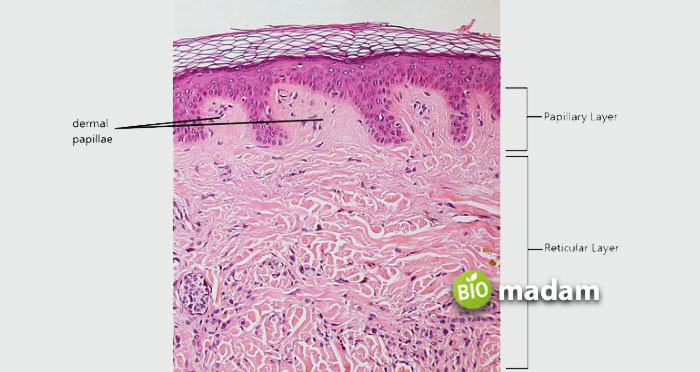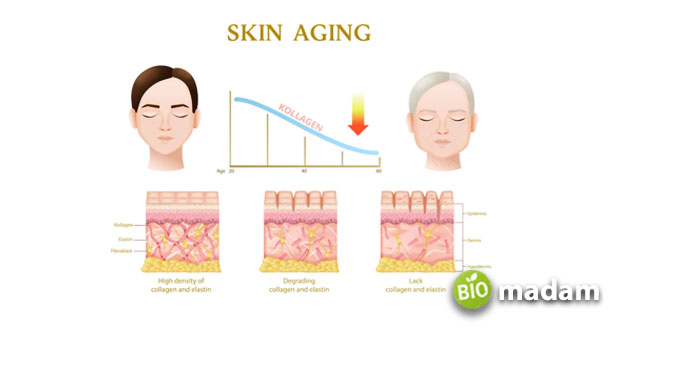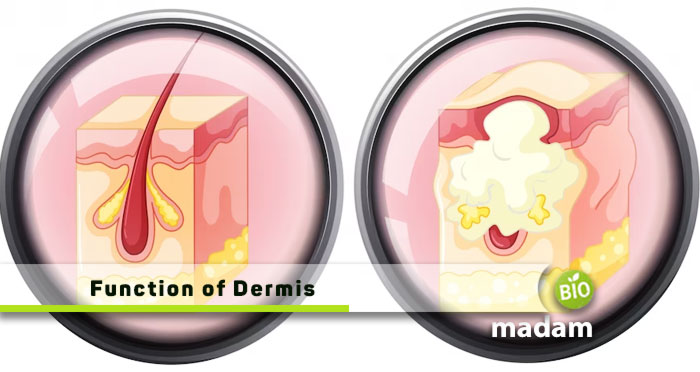Recently updated on March 14th, 2023 at 06:57 am
The word “dermis” is related to the skin, which plays a major role in protecting your body from the external environment. Skin is the largest organ of the body that acts as the first line of action against antigens and pathogens to save body cells, tissues and organs from any damage. The skin comprises three layers; the dermis lies in the middle. Keep reading to learn the anatomy and functions of the dermis in detail.
What is Dermis?
The dermis is one of the three layers of the skin: hypodermis, dermis, and epidermis. The epidermis is the outermost, the dermis resides in the middle, whereas the hypodermis is the innermost layer. The dermis supports the epidermis.
The dermis contains nerves, blood vessels, hair follicles, collagen, different types of glands, etc. It also comprises fibroelastic tissue that contains various cells like stem cells, macrophages, fibroblasts, mast cells, etc.
The thickness of the dermis may range from 0.6mm thick in the eyelid to 3mm thick in the plantar skin.
Layers of the Dermis
While it seems simple, the dermis is further divided into two layers: The reticular dermis and the papillary dermis.
Reticular Dermis
The reticular dermis merges with the inner side of the papillary layer. Thus, its border cannot be properly distinguished. It is the bottom layer of the dermis and is quite thick. The reticular dermis contains glands, lymph nodes, nerves, glands, fat cells, and hair follicles. It also has a network of fibrous proteins, performing several functions. Fibrous proteins include collagen, elastin, and connective tissues, allowing your skin to stretch and move.
Papillary Dermis
The papillary dermis is the outer layer of your dermis. It is thinner than the reticular dermis and comprises collagen fibers, blood vessels, receptors, and macrophages that fight with bacteria and viruses. It is based on elastic fibers, type III collagen, and a capillary network that provides blood to the epidermis. Opposed to the reticular dermis, the papillary dermis connects to the epidermis in an interlocking manner.

Tissues of the Dermis
The dermis primarily consists of three layers of tissues that run throughout the middle skin layer instead of the layers. These include:
- Elastic tissue
- Collagen
- Reticular fiber
Function of the Dermis
Now that you know the composition and layers of the dermis, let’s tell you about the functions of the dermis.
Support to the Epidermis
As we mentioned earlier, the dermis acts as a support to the epidermis. It transports macro and micro nutrients to the epidermis and provides flexibility and strength to the innermost layer of the skin.
Sensitivity
Your dermis contains nerve endings that allow you to feel sensations, including coldness, hotness, pain, and pressure. It also plays a role in enabling you to feel an itching sensation.
Sweat Production
The dermis contains sweat glands that produce sweat when your body experiences a higher temperature, contributing to thermoregulation. Sweating allows your body to cool itself and get rid of toxins. Sweat glands may also produce sweat as a response to stress and anxiety.
The sweat glands in the dermis are of two types: apocrine and eccrine. Apocrine glands are common in the scalp, armpits, and genitalia. When sweat interacts with the skin bacteria, it produces an odor. On the other hand, eccrine sweat glands release the sweat directly onto the skin’s surface. They are present in the armpits, forehead, feet, and palms.
Lubrication
Besides sweat glands, the dermis also contains sebaceous glands that secrete sebum to keep your skin hydrated and lubricated. The sebum may trap external pathogens and prevent their entry to protect you from bacterial and viral infections.
Hair Follicles
The hair follicles in the dermis contribute to hair production from your skin. Hair follicles are present almost all over the skin in mammals except the sole of your feet and the palms of your hand. These hair follicles also exhibit the phenomenon of goosebumps. The hair follicles are connected to arrector pili muscles that contract when you experience stress or cold.
Acts as a Foundation
The dermis provides a shape to the skin. It is responsible for maintaining the turgor of the skin and acting as a foundation for the hypo and epidermis.
Dermis and Aging
The process of aging results from the changes in the hypodermis, dermis, and epidermis when we grow older.
As we age, collagen production reduces, and elasticity loses its elasticity, leading to a thinner dermal layer. This contributes to saggy and wrinkled skin. The distance between the dermis and epidermis also increases with time, and the epidermis loses the support provided by the dermis. It reduces the supply of macro and micronutrients to the skin for proper growth and maintenance. Moreover, the sweat and sebum production reduction by the sweat and sebaceous glands makes the skin dry. It is a major feature of aging skin.

How to Keep the Dermis Healthy?
Keeping the dermis healthy is essential to avoid skin diseases and disorders and also prevent the signs and symptoms of aging. Here’s how you can keep your dermis healthy:
- Do not ignore your wounds and treat them properly. Wash our wounds with running water and apply a suitable ointment to prevent infections. Unless it is a burn, cover the wound with a bandage to avoid the entry of bacteria and dirt.
- Protect your skin from the sun by using sunscreen whenever you leave the house. Use a sun protectant lotion with SPF 30 or more, depending on your skin and the sunlight intensity in your surroundings. Long exposure to UV rays can damage your skin and is one of the causes of cancer (melanoma/ basal cell carcinoma).
- Drink at least eight to twelve glasses of water daily to stay hydrated.
- Follow a skincare routine according to your skin type. Cleanse and moisturize your skin daily. Use a mild scrub or exfoliator or keep dirt away from your skin.
- Consult a doctor if you observe unusual changes in your skin.
The Bottom Line
The dermis is the middle layer of the skin between the hypodermis and epidermis. It contains sweat glands and sebaceous glands to keep your skin moisturized and protect you from infections and diseases due to foreign bodies. The dermis acts as a foundation and support to your epidermis and provides it with all essential nutrients. It also contains elastic tissue, collagen, and reticular fiber that gives it a shape and allows stretching.
FAQs
What is the function of the epidermis and dermis?
The epidermis is the outermost layer of the skin and is the first line of defense to protect your body from external bodies. The dermis resides below the epidermis and contains hair follicles, collagen, sweat glands, and sebaceous glands.
How does the dermis protect the body?
The dermis contains macrophages that protect the body from microorganisms, like bacteria, archaea, and similar pathogens. They destroy different types of harmful antigens, including bacteria, and kill toxic elements that pass the epidermis.
What is unique about the dermis?
The dermis provides nutrients to the epidermis and provides flexibility and strength to the skin. It comprises elastic and connective tissues, making it the skin’s thickest layer.
What are the three functions of dermal tissue?
The dermal tissues in plants contribute to water and gaseous exchange in the plants. They also protect the plant and enable the absorption of vitamins and minerals.

Hello, I would like to introduce myself to you! I am Chelsea Rogers, an experienced blog writer for science articles, holding an MPhil degree. My enthusiasm to grab the best knowledge, let it relate to botany, zoology, or any other science branch. Read my articles & let me wait for your words s in the comment section.

